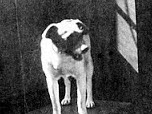Taro and Jiro became famous dogs in history for their will to live when left behind in Antarctica, having survived on their own for 11 months in extremely harsh conditions.
 |
| Taro and Jiro greeted by the men from the expedition that found them. |
Taro and Jiro, three year old male siblings, were the youngest of 15 sled dogs of the first Japanese expedition to Antarctica that started in January 1957. The dogs were Sakhalin huskies, known in Japan as Karafuto-ken, a beloved Japanese dog that was well-suited to snowy climates.
The first team, consisting of 11 researchers, were to be replaced by another team in February 1958. However, before the second team could arrive a strong and unexpected storm approached causing the first team to be evacuated by helicopter and the second team to be suspended. Unfortunately, the dogs had to be left behind. They were chained and given food to last them for a few days, when the team had hoped to return for them. Sadly, the men could not return until the following year.
On January 14, 1959, the expedition returned to the base in Antarctica. The men were expecting to find the 15 dogs dead but only seven (Aka, Goro, Pochi, Moku, Kuro, Pesu and Kuma from Monbetsu) lost their lives while still chained. The other eight dogs had managed to break free from the chains. Amazingly two of the dogs, Taro and Jiro, were found alive near the base. The remaining six (Riki, Anko, Deri, Jakku, Shiro and Kuma from Furen - this Kuma was the father of Taro and Jiro) were never found.
Taro and Jiro were able to survive the 11 months in extreme conditions without human support, and apparently did not resort to eating the bodies of their fellow dogs. Yasukazu Kitamura, Professor Emeritus of Kyushu University and caretaker of the dogs, described "The stored foods for human and dog in Showa base were intact. Some types of dogs have to cannibalism during the famine. Seven dogs were found in dead which were connected to chains, while the bodies were intact. I think that Sakhalin dogs ate penguins, feces of seal, seabirds and fishes (trapped in the ice)."
Taro and Jiro stayed in Antarctica to pull sleds for the new expedition. In 1960 Jiro died of a disease in Antarctica and in 1961 Taro returned to his hometown Sapporo and lived at Hokkaido University until he died of old age in 1970. Taro's body was embalmed and is on display at the Museum of National Treasures at the Botanical Garden of Hokkaido University, and Jiro's body was embalmed and is on display at the National Museum of Nature and Science in Tokyo - the same museum where Hachiko (Japan's most loyal dog) is on display.
 |
| One of the monuments (part of it) honoring the dogs that were left behind. |
Monuments were erected in Japan honoring Taro, Jiro and the dogs who lost their lives, and two movies were made based on their story - Nankyoku Monogatari in 1983 and Eight Below in 2006.







